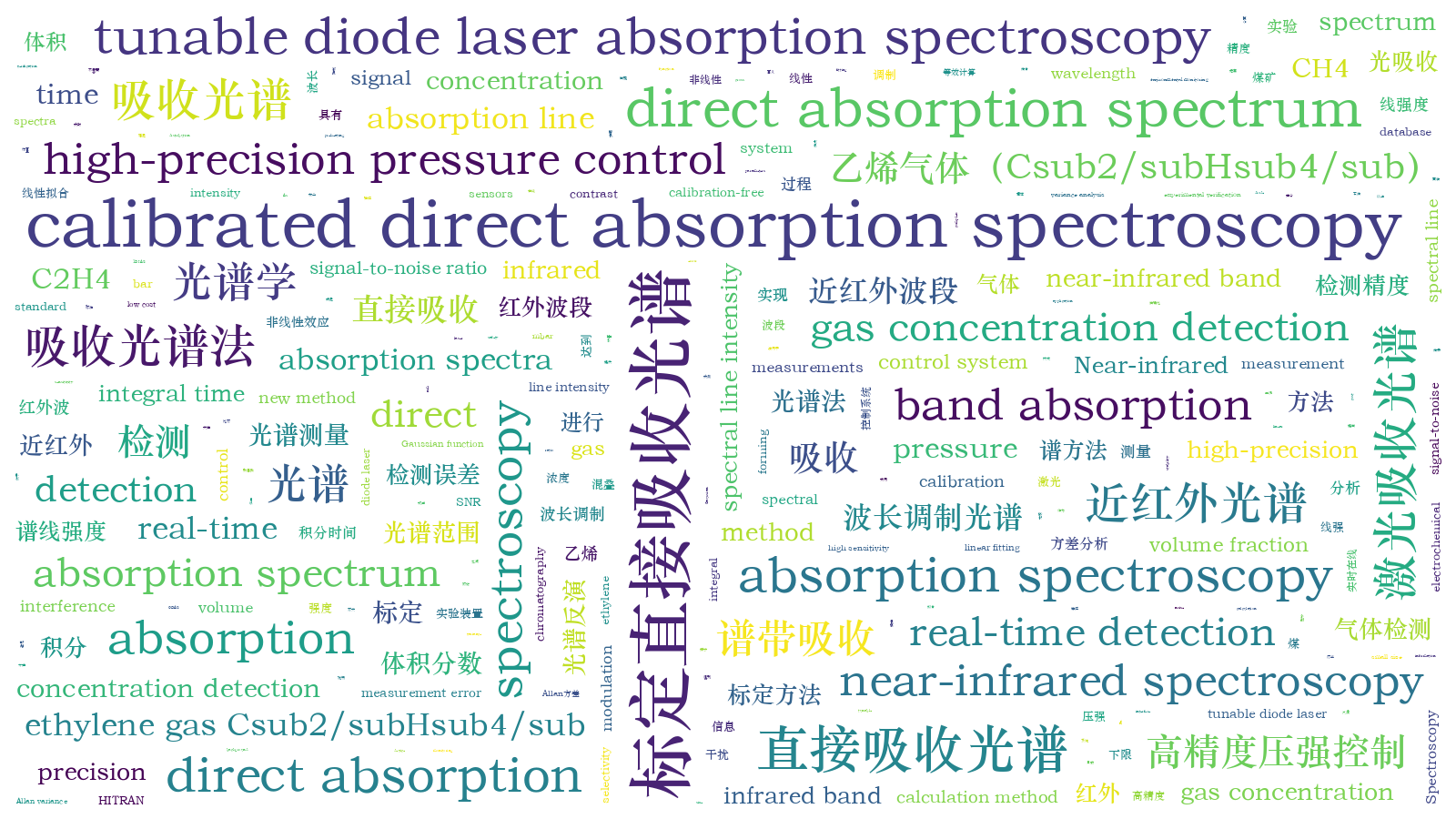基于标定直接吸收光谱方法的近红外乙烯检测【增强内容出版】
The real-time detection of ethylene (C2H4) is significant for the safety of coal mines, the petrochemical industry, and other industries. Currently, the mainstream methods for C2H4 gas concentration detection include gas chromatography and electrochemical sensors. Gas chromatography can separate multicomponent gases and avoid mutual interference. However, this method requires long-term preheating and frequent calibration, making it difficult to complete real-time measurements in industrial scenarios. Although electrochemical sensors have the advantages of small size and low cost, their selectivity is poor, and it is difficult to avoid cross-interference. In contrast, tunable diode laser absorption spectroscopy (TDLAS) has the advantages of real-time measurements, high sensitivity, and strong selectivity. They are widely used in industrial gas detection and environmental monitoring. Unfortunately, there are still some difficulties in real-time high-precision detection of C2H4. First, information regarding the absorption line of C2H4 in the near-infrared band cannot be obtained. Second, the absorption spectrum of C2H4 is described as complex band absorption. Third, the absorption spectra of C2H4 and CH4 in the near-infrared band interfere with each other. Therefore, real-time high-precision detection of C2H4 is a common problem that urgently needs to be addressed.
First, the gas concentration can be calculated using traditional direct absorption spectroscopy if the accurate parameters of the absorption line are known. However, for C2H4, it does not contain an absorption line intensity within the near-infrared band in the HITRAN database. This results in an inability to use a calibration-free method to directly calculate the C2H4 concentration. Notably, the concentration calculation method in wavelength modulation spectroscopy does not require accurate spectral line intensity. Therefore, the calibration concept of wavelength modulation spectroscopy is applied to the direct absorption spectroscopy, forming a method named calibrated direct absorption spectroscopy. In addition, faced with the problems of the band absorption of C2H4 and the interference of CH4, a high-precision pressure control system is utilized to complete the spectral line separation under low pressure. In contrast to previous studies, it is necessary to select an appropriately calibrated spectrum in this study. Specifically, standard CH4 and C2H4 gases are measured at a pressure of 100 mbar (1 bar=105 Pa) and the corresponding direct absorption spectra are obtained. By comparing with the simulated spectrum of CH4 in the HITRAN database, the appropriate calibrated spectrum of C2H4 is determined.
Stable pressure plays a vital role in the experiments. After the pressure value stabilizes to 100 mbar, the pressure results of the continuous measurement within 1 h are collected, and the distribution of the pressure results is well fitted by a Gaussian function; the full width at half maximum is 0.008 mbar, which proves the stability of the experimental system for pressure control. The subsequent experiments are conducted at 100 mbar. Within the volume fraction of less than 100×10-6, the direct absorption spectrum signals of five sets of C2H4 are acquired and the concentration results are also calculated. The correlated coefficient of linear fitting between the result and the standard concentration is greater than 0.999, and the maximum measurement error is -1.47×10-6. In addition, a direct absorption spectrum signal of 10×10-6 C2H4 is selected for limit of detection (LoD) analysis. The peak value of the signal is 5.80×10-4, and that of the background signal is 0.80×10-4, which can be calculated to obtain a signal-to-noise ratio (SNR) of 7.25. The concentration corresponding to one SNR is defined as the LoD, and its value is 1.38×10-6. Finally, C2H4 with a volume fraction of 20×10-6 is continuously measured for 40 min, and Allan variance analysis is performed on the volume fraction results. At an integral time of 1 s, the precision of measurement for C2H4 is 0.61×10-6. As the integral time increases, the detection precision can reach 0.04×10-6.
To address the challenges faced in near-infrared ethylene detection, a calibrated method in wavelength modulation spectroscopy is applied to direct absorption spectroscopy, forming a new method known as calibrated direct absorption spectroscopy. An experimental device for C2H4 detection with a high-precision pressure-control system is established, and the direct absorption spectrum of C2H4 is measured at approximately 1626 nm. Based on experimental verification, the calibrated direct absorption spectroscopy method can complete the real-time detection of C2H4, overcoming the limitations of traditional direct absorption spectroscopy. We also hope to address real-time detection problems of other similar gases, which can significantly expand the application of direct absorption spectroscopy.
王前进, 孙鹏帅, 张志荣, 蔡永军, 黄文彪, 庞涛, 夏滑, 吴边. 基于标定直接吸收光谱方法的近红外乙烯检测[J]. 中国激光, 2024, 51(8): 0811004. Qianjin Wang, Pengshuai Sun, Zhirong Zhang, Yongjun Cai, Wenbiao Huang, Tao Pang, Hua Xia, Bian Wu. Near-infrared C2H4 Detection Based on Calibrated Direct Absorption Spectroscopy[J]. Chinese Journal of Lasers, 2024, 51(8): 0811004.







